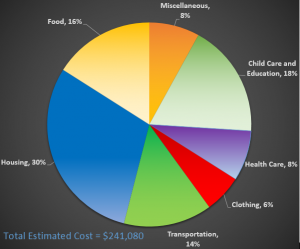A toddler clinging to Mom’s fingers steps into Daddy’s arms. A history textbook sits open on the chair. Across the street, another mother bathes her baby in warm water. Her chemistry notes, scribbled on a piece of paper, are taped to the mirror. Another father rocks the baby as he reviews credit card bills from the past month.

Balancing a family and a job was never easy. Adding school into the equation complicates the situation even further.
The cost of children
In a talk given by Elder Cecil O. Samuelson in 2004, he revealed that almost half of the graduates of BYU were married and 16 percent had children.
He joked, “Our historical data predict that in the next three years 83 percent of you will be married, so we suggest particularly that the parents of the single women start to plan ahead as you juggle your finances.”
The costs of raising children have risen in the past decade, but there are many government programs available to help new parents afford and care for young children.
According to the USDA report, total expenses and expenditures on a child in 2012 reported 0–2-year-olds costing $12,710 annually. The cost grows as a child gets older.

The total cost of a child from birth through age 17 is approximately $241,080. In 1960, the cost was $195,690 (adjusted to 2012 dollars). Since 1960, the cost of raising a child has increased by approximately 4 percent each year.
Deciding when to start paying these costs is a big decision as well. According to government statistics, the average age of a mother at her first birth is 25. Utah’s average age is a bit younger at 23.9.
This data pins the average at a year later than the same statistic taken almost two decades ago. The reasons for the delay typically include career aspirations, financial difficulties and familial responsibilities.
Daniel Olmstead, who is father to an 8-month-old girl and taking classes, said, “I would advise anyone that they should weigh all their options and prayerfully decide what to do rather than basing the decision on any single factor such as finances or how quickly you’ll finish school.”
Help available for couples
Although the costs of having children have risen over the past few years, there are many programs available to young families in order to compensate for the costs of having children.
BYU student insurance
All students at BYU are required to have student insurance in order to avoid free loading and to “protect students against the potentially high cost of unexpected medical care,” the Student Health Center said.
Although many students are on their parents’ insurance, the BYU student insurance plan provides services and maternity benefits for new mothers
Contracted rates cover basic prenatal care, delivery and a six-week checkup after delivery. The plan pays for 80 percent of the cost to contracted providers.
Due to the higher number of pregnancies compared to other colleges, BYU’s insurance for new mothers and children is substantial.
More details can be found at the Student Health Center site and in its maternity and new baby pamphlet.
Medicaid

According to the American Pregnancy site, Medicaid is offered to “low income families who have no medical insurance or inadequate insurance.” Traditionally eligible members include children, pregnant women and disabled adults.
These eligibility requirements are set up by the state, and there are different programs for children in various age groups as well as for women.
For a pregnant woman, medical assistance is provided from the day she submits an application until 60 days after birth. The child is then able to receive assistance until it is 1 year old.
Brett Clark, who has a 21-month-old daughter, explained, “We were on Medicaid to cover the pregnancy, birth and first-year appointments.”
In order to apply for Medicaid, visit the site containing Utah Medicaid information. Proof of pregnancy, citizenship and income is required.
Women, Infants and Children Program
The Women, Infants and Children Program provides nutrition education counseling to help pregnant women, new mothers and children (up to their 5th birthday) stay healthy.
The WIC center has classes on breastfeeding, health and budgeting. A nutritionist is also available for participants.
In order to encourage healthy eating, a qualified participant is given vouchers that act like checks at participating WIC stores. A list of approved foods is provided, and vouchers must be used within a certain time period.
Some of the foods listed on the authorized foods booklet from the program’s site include juice, fruits and vegetables, beans, cereal, whole grains, rice and baby food.
Chris Furner, WIC program manager for the Utah Department of Health, explained the purpose of the program: “Healthy eating means healthier families. We want them to have the best start.”
The program is 100-percent federally funded, and Congress provides a budget annually. This budget changes based on the needs of the state.
In order to establish eligibility status, a call should be made to the clinic at 1-877-WIC KIDS. Interested applicants can also view the benefits on the site.
After determining eligibility, the WIC center will schedule an appointment with the woman. Mothers should bring a spouse or a significant other to the appointment. The second individual will be certified and able to pick up food for the mother and children.
It is also necessary to bring identification, immunization records, proof of residency, proof of income and the child to the appointment. After asking some questions, a nutritionist will sit down and discuss health practices and provide the necessary vouchers.
The Utah WIC site also has information for fathers about raising children and websites that help new fathers. One of the websites has video examples of how to change diapers, bathe and play games with a baby.
The costs of parenthood might be rising, but programs are here to help. As Furner said, “Anyone who thinks they might be eligible, please call.”




